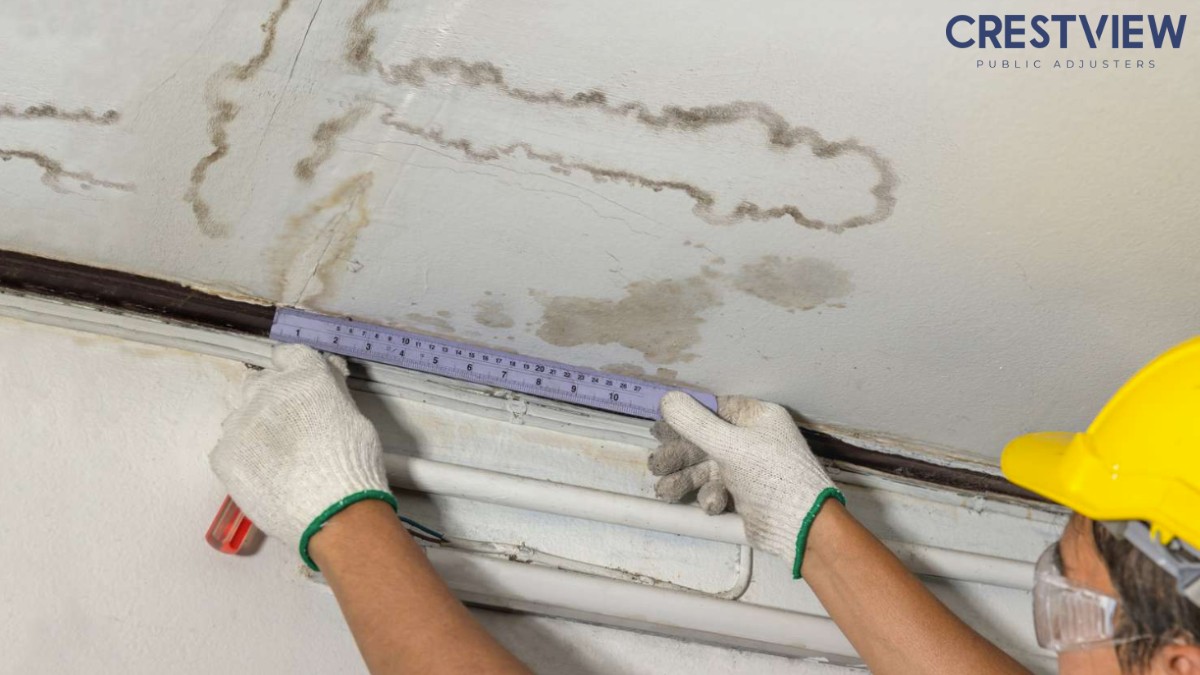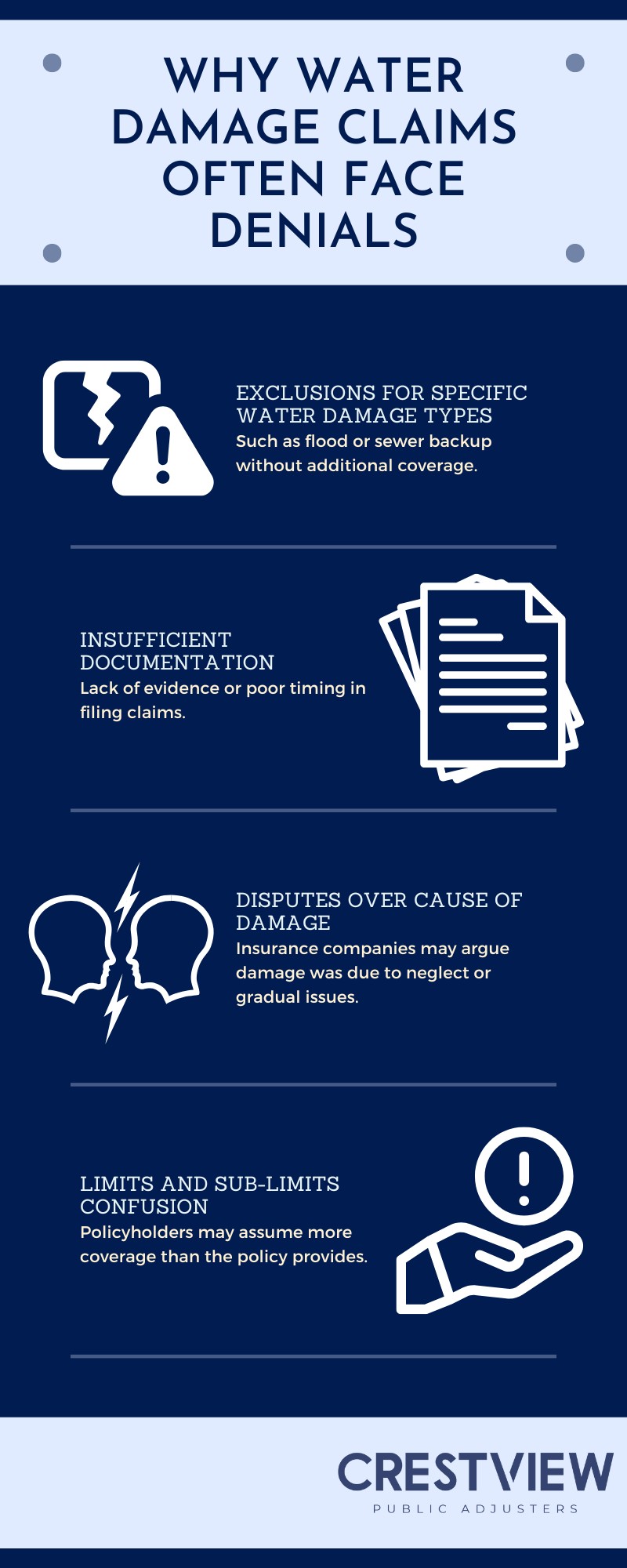Key Points:
- Understanding your insurance coverage limits is crucial in water damage claims to avoid unexpected out-of-pocket costs.
- Water damage claims often face complications due to policy exclusions, deductibles, and sub-limits related to water-related incidents.
- Public adjusters can help navigate claim disputes and maximize settlements by thoroughly analyzing coverage details and damage assessments.
Water damage affects nearly 14,000 U.S. households daily, costing billions annually in property repairs and losses. Despite the prevalence of water-related incidents—from burst pipes to flooding—many policyholders misunderstand how their insurance coverage limits apply to these claims. Knowing the scope of your coverage can mean the difference between full repair and costly out-of-pocket expenses.
Do Insurance Coverage Limits Affect Water Damage Claims?
Yes, insurance coverage limits directly impact the payout you receive on water damage claims. These limits define the maximum amount your insurer will pay for covered losses. If your claim exceeds these limits, you must cover the difference yourself.
For example, if your home insurance policy has a $50,000 limit for water damage and your damages total $70,000, you are responsible for the remaining $20,000. It’s critical to understand these limits before filing a claim to manage expectations and financial planning effectively.
What Are Insurance Coverage Limits in Homeowners Policies?
Insurance coverage limits refer to the maximum dollar amount an insurer agrees to pay for a covered loss under a policy. These limits apply separately to different types of coverage within a policy, such as dwelling, personal property, and additional living expenses.
Water damage claims usually fall under the dwelling coverage or a specialized water damage endorsement. There are typically several limits relevant to water damage:
- Overall policy limit: The total maximum payout for all covered losses during the policy term.
- Coverage sub-limits: Specific caps within a policy section, such as a maximum for water backup or flood damage.
- Perils limits: Some policies restrict coverage to certain water damage causes like plumbing leaks but exclude others like floods.
Understanding these distinctions is vital because a high overall limit doesn’t guarantee full reimbursement if water damage falls under a restricted sub-limit or exclusion.

How Do Deductibles Impact Water Damage Claims?
Before your insurer pays any claim amount, the deductible must be paid out-of-pocket by the policyholder. Deductibles for water damage claims can vary widely based on the policy and the specific cause of damage.
Common deductible types include:
- Flat deductible: A fixed dollar amount, for example, $1,000 per claim.
- Percentage deductible: A percentage of the dwelling’s insured value, often seen in hurricane or flood-prone areas.
- Separate deductibles: Some policies impose separate deductibles for water-related incidents, like water backup or sump overflow.
Deductibles can reduce claim payouts significantly. For example, if you have a $5,000 deductible and your total damage is $20,000, your insurer pays only $15,000. Policyholders should confirm their deductible amounts for water damage and consider this when evaluating the true extent of their coverage.
What Types of Water Damage Are Covered by Homeowners Insurance?
Not all water damage claims are created equal. Standard homeowners insurance typically covers sudden and accidental water damage but excludes certain types of flooding or gradual damage.
Common water damage types generally covered:
- Burst or leaking pipes: Sudden pipe bursts causing damage inside the home.
- Appliance leaks: Unexpected water leaks from appliances like washing machines or water heaters.
- Water intrusion from rain: Damage caused by rain entering through a damaged roof or window.
Common exclusions or limited coverage:
- Flood damage: Usually excluded and requires separate flood insurance through FEMA or private carriers.
- Sewer backup: Often excluded or limited unless specifically added via an endorsement.
- Gradual leaks or seepage: Damage caused by slow leaks over time is often not covered.
Understanding these distinctions can help policyholders avoid denied claims or surprise out-of-pocket costs due to misunderstood coverage boundaries.
How to Maximize Your Water Damage Claim Within Your Insurance Coverage Limits
Water damage claims can quickly become complex due to the nature of damages and policy language. Here are key strategies to help maximize your payout:
- Document everything thoroughly: Take photos, videos, and detailed notes of all damage and repairs needed.
- Review your policy carefully: Know your specific water damage coverage limits, exclusions, and deductible amounts.
- File claims promptly: Insurance companies may deny claims for delayed reporting.
- Keep all receipts and estimates: For temporary repairs, cleaning, and professional damage assessments.
- Consider hiring a public adjuster: Experts who specialize in evaluating damage and negotiating with insurers to ensure claims reflect the true scope of loss.
These steps can reduce surprises and improve the chances that your water damage claim receives fair compensation.
Why Do Water Damage Claims Often Get Denied or Underpaid?
Many water damage claims face denials or underpayments due to misunderstandings about policy coverage or insurer practices. Common reasons include:

Being proactive about understanding your insurance policy and knowing your rights can help prevent or contest unfair claim outcomes.
What Role Do Public Adjusters Play in Water Damage Claims?
Public adjusters work on behalf of the policyholder, not the insurance company. Their job is to:
- Assess the full extent of water damage.
- Interpret complex policy language related to insurance coverage limits and water damage claims.
- Prepare detailed claim reports and documentation.
- Negotiate directly with insurers to seek the maximum claim settlement possible.
Leveraging their expertise, public adjusters can often secure higher settlements than policyholders might on their own, especially when disputes over limits or coverage arise.
Call to Action: Secure Your Water Damage Claim with Expert Public Adjusters
Facing the complexities of insurance coverage limits and water damage claims, having an expert by your side makes all the difference. Crestview Public Adjusters specialize in handling water damage claims across New York, New Jersey, and Florida. Our team thoroughly evaluates your property damage, understands your policy inside and out, and fights to maximize your insurance payout.
Don’t leave your water damage claim to chance—partner with Crestview Public Adjusters to ensure your settlement reflects the true cost of repairs and losses. Contact us today to get a free consultation and take control of your insurance claim with confidence.

